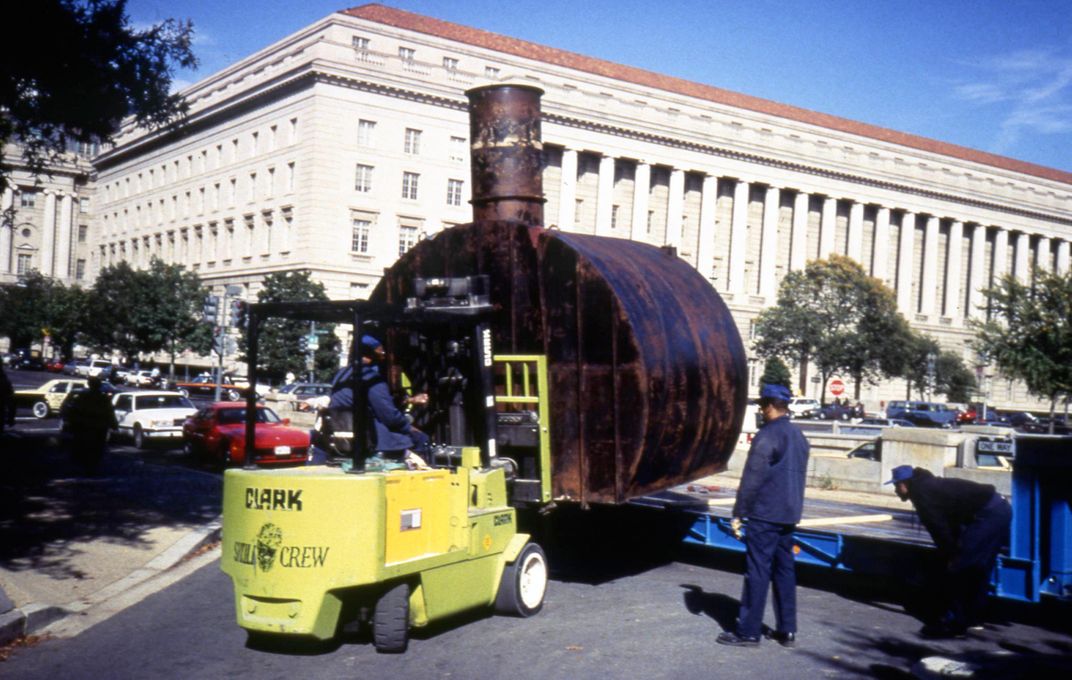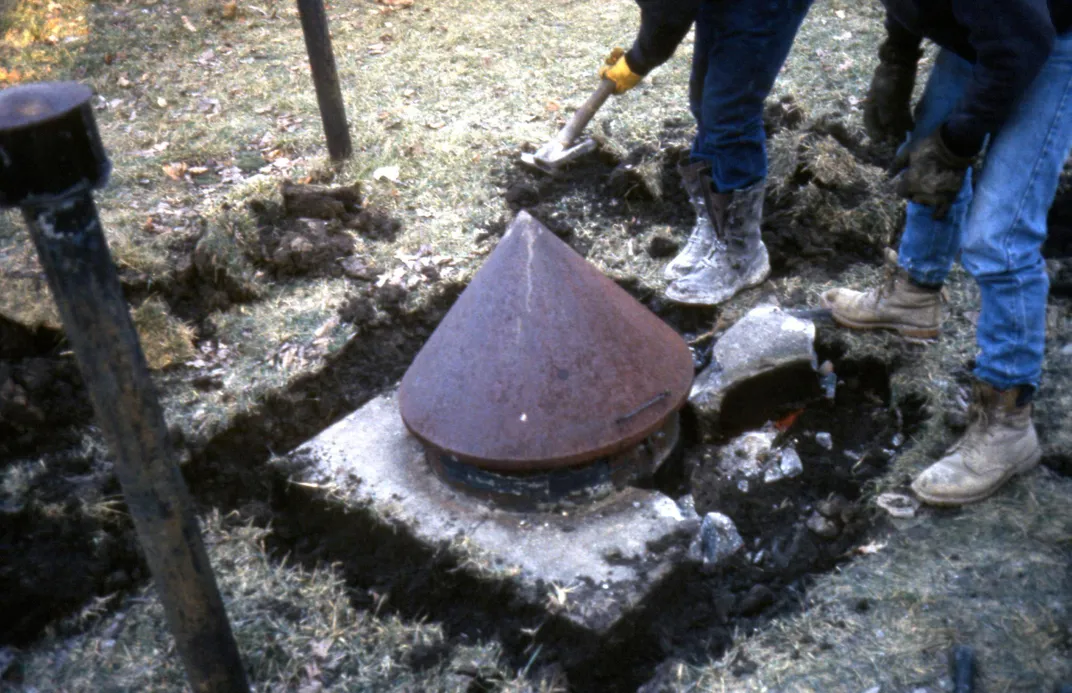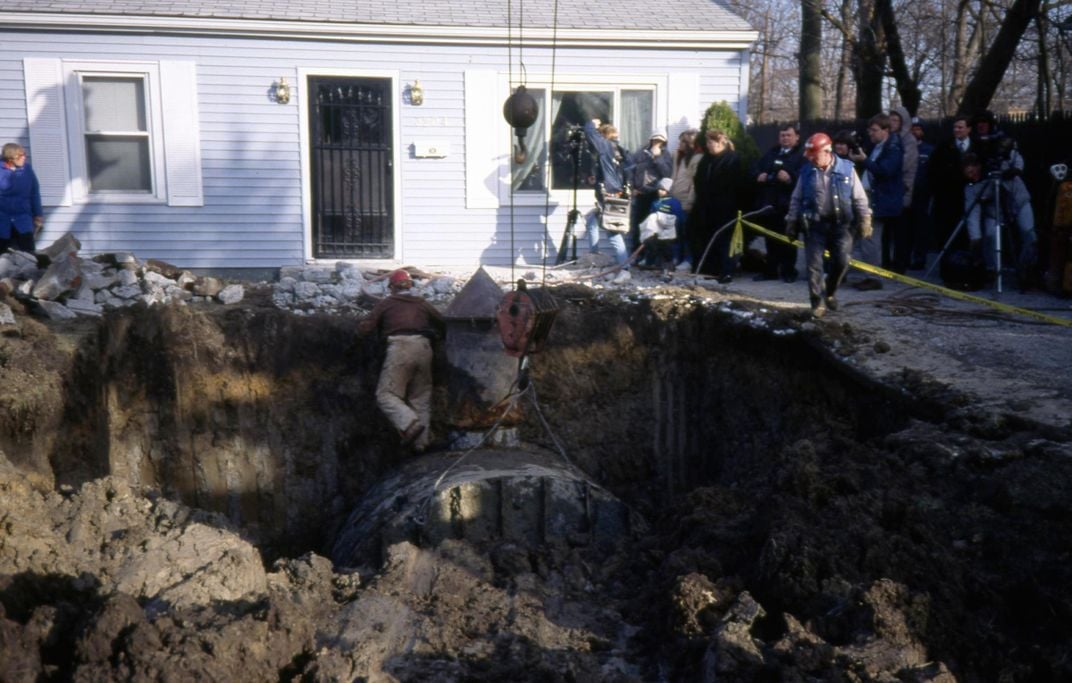Dig Into the Nuclear Era’s Homegrown Fallout Shelters
In 1955, the head of Civil Defense urged everyone to build an underground shelter “right now”
/https://tf-cmsv2-smithsonianmag-media.s3.amazonaws.com/filer/e3/15/e3157d82-efdf-404e-a85a-8f469066b445/4443271711_8f89628a4a_o.jpg)
Ever since war makers invented weapons that go up in the air, then come down and go boom, defenders have been trying to protect themselves against death from the sky.
In America's Civil War, particularly in the last months when Petersburg was under siege, dug-in soldiers on both sides built "bomb-proofs" with ceilings of heavy logs and earth to shield against plunging mortar fire. In World War I, troops on the muddy, stationary Western front existed beneath such shelters for months, at all times of the year. In World War II, the citizens of London crowded into subway tunnels as Nazi aircraft and missiles attacked night after night. In this country, Boy Scouts learned the silhouettes of enemy bombers, to identify them and rush people to shelters in case of raids that never came.
But not until August 6, 1945 did America and the world realize there was a weapon so horrible that one bomb could destroy a whole city at once, and poison it for years afterward. The first news reports could not adequately describe the devastation that American B-29s had released onto Hiroshima and then Nagasaki.
Full disclosure came a year later in John Hersey's magazine account, based mainly on interviews with survivors that detailed the scale and gruesomeness of what had happened in Hiroshima and filled an entire issue of the New Yorker.
Yet even then, most Americans thought of the nuclear bomb not as an external threat but as exclusively our weapon, our defense. It symbolized our nation's military, political and scientific dominance in the postwar world. The mere presence of the bomb in the U.S. arsenal seemed to assure the safety of our children and our allies.
That certainty lasted just four years. Aided by secrets stolen by spies in the American nuclear establishment, the Soviet Union conducted its first nuclear test on August 29, 1949. In Washington soon after, Douglas MacArthur's ex-wife said she was furnishing the former slave quarters beneath her Georgetown mansion as a bomb shelter. In Congress, a New York Democrat introduced a bill asking $2 billion for underground shelters that would double as parking garages. In New Jersey, three World War II veterans started a construction business and offered to build shelters that could double as wine cellars. In 1952, the Army Corps of Engineers boosted its cost estimate for the shelter being built under the White House to $938,000.
A year later, the Russians set off their first hydrogen bomb. With that in mind, in 1955 the head of Civil Defense urged everyone to build an underground shelter "right now," and in Fort Wayne, Indiana, the Anderson family installed an all-steel bunker 15 feet beneath their front yard. Two years after that, Soviet scientists startled the world by launching Sputnik, the first man-made satellite, with technology that would soon be able to deliver a missile from space. Bomb shelters suddenly became a growth sector of the economy.
Each twist in the cold war sent another jitter across the nation. At the United Nations in 1959, Soviet Premier Khrushchev bragged about his hydrogen bombs. When the legislature in Albany balked at Governor Rockefeller's plan for public shelters, the New York Times editorialized: "Horrible as the prospects are in a nuclear attack, the question we face is, should we try to survive or should we, in advance, abandon all hope, deliberately choose to make no preparation to live?"
In metropolises and in distant villages, the answer from thousands was to dig.
Tension peaked when Khrushchev tested the new American President Kennedy by threatening to cut Western access to divided Berlin, and then by installing offensive missiles in Cuba.
Life magazine published an article titled "H-Bomb Hideaway" that included shelter plans with photographs and specifications. In public and private schools, often in towns far away from any strategic target, children were taught to crouch beneath their desks if an alarm sounded. Families practiced staying in their tightly shut private shelters for several days at a time, as if waiting for deadly radiation to pass after an attack. Debates arose over whether families with shelters were morally obligated to share them with unprepared neighbors or strangers in case of war.
In Moscow, Western attachés counted directional signs to shelters, thinking that more signs might mean impending war. In 1965, civil defense officials listed hundreds of buildings as fallout shelters in Washington, D.C.
Then when the long East-West struggle relaxed and communism collapsed in Europe, such signs gradually disappeared. But since then concerns have risen about the spread of nuclear, chemical, biological and rocket weapons in lesser nations. Well into the 21st century, senior American defense experts were warning that attack could come from many directions, including Iran and North Korea.
So, even today, some Americans are on the market for private shelters. A glance online shows at least two dozen commercial versions for sale, some luxurious, some spartan, some concrete, some steel, some advertised as "hardened structures," at least one as an "apocalypse bunker" made to withstand a 20-kiloton bomb blast. Many, too, in this era of chaotic weather, are offered to protect against hurricanes, rather than direct attack by human enemies.
By whatever name, emergency shelters have been a part of American life and history for generations. And that is why the front-yard shelter installed 61 years ago by the Andersons of Fort Wayne now rests among the collections of the Smithsonian's National Museum of American History.
Its most recent owners, the Howey family handed it over. They must have been glad to let it go after it became an unattractive neighborhood curiosity. Digging it up and getting it to Washington was an expensive logistical problem, and it's easy to see why: looming bare above ground, it looks like the carcass of a monster steam locomotive, a boiler with pointy smokestack, bereft of its wheels.
But now it is cleaned up, stocked with 1950s furniture, games and perhaps Elvis’s “Blue Suede Shoes” at 45 rpm. It represents Shelter, with a capital S, and poses a question that fortunately remains unanswered: since such shelters were never tested by nuclear war, whether they would have been sanctuaries or death traps is still uncertain.
The Family Fallout Shelter is currently not on view at the museum.
/https://tf-cmsv2-smithsonianmag-media.s3.amazonaws.com/accounts/headshot/DSCN0003-001.JPG)



/https://tf-cmsv2-smithsonianmag-media.s3.amazonaws.com/accounts/headshot/DSCN0003-001.JPG)